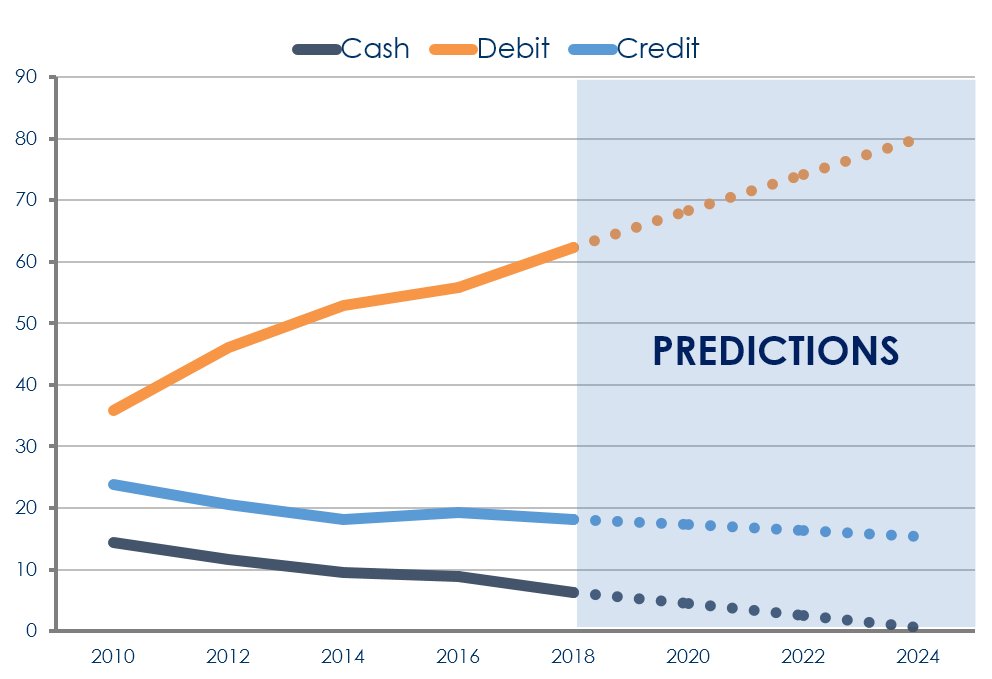Is a cashless society fact or fiction?
(26 April 2017 – Australia) Australian merchants have reported that cash receivables plummeted by 46 percent between 2010 and 2016, new research from market analysts East & Partners has found. Should this trend continue, cash payments across all Australian businesses is predicted to fall below five percent by 2019 and then hit two percent within the next five years.
Over the same period, data from East & Partners’ Australian Merchant Payments Report – which directly interviews 2,200 business annually – shows credit card payments have also dropped by 11 percent, while debit card receivables have surged by 56 percent.
“Backed by recent figures from the Reserve Bank showing ATM withdrawals falling to all-time lows, East’s research indicates that cash is increasingly vanishing as a preferred payment method,” said Martin Smith, Head of Markets Analysis at East & Partners.
“As consumers continue to embrace platforms such as wearables, contactless and mobile payments, and they’re further integrated into everyday life, the need to carry cash will continue to diminish at an accelerating rate.
“Additionally, the Reserve Bank’s surcharging limits coming into effect later this year, will spur consumers to use payment options linked to their debit and credit cards more for everyday purchases.”
Recognising the increased influence of technology across merchant payment products, East extended the scope of the Merchant Payments Report to include Australian businesses’ feedback on non-bank point-of-sale terminal penetration, cloud accounting integration, and the upcoming New Payments Platform (NPP).
East & Partners Australian Merchant Payments Report shows a marked increase in businesses’ online presence. Currently, 82 percent of merchants say that they either “accept” or “plan to accept” online payments, compared to just 15 percent in 2010.
In contrast, far fewer businesses have migrated to “mobile friendly” websites and payment platforms. According to the research, only one in five of all Australian merchants say that their website has a “mobile friendly” browsing functionality, anchored by the Micro segment, of which only 15 percent have reported an optimised mobile payment offering.
“Despite Australia’s rapid adoption of mobile devices, it’s disappointing to see so few small businesses meeting demand. However, that provides a distinct opportunity for payment platform providers to step in, educate and enhance these businesses competitiveness against larger more digitally enabled enterprises,” said Smith.
In the increasingly competitive point-of-sale (POS) market, providers such as PayPal and Tyro enjoy the highest market penetration among non-bank providers. New entrant Square Payments is quickly gaining traction with 8.4 percent of all businesses reporting either using, or having considered using the mobile friendly credit card reader.
“Although the big banks have control of the POS terminal market, through their size and direct relationship with businesses, non-bank providers are presenting fierce competition by offering simple, affordable and feature rich products,” said Smith.
While online transaction reporting and management is a future technology priority for one third of all businesses, 43 percent said they have integrated a cloud accounting platform such as Xero or MYOB in their payment systems.
Alarmingly for the Reserve Bank, NPP Australia and financial institutions such as SWIFT contributing to the design, development and operation of the New Payments Platform (NPP), awareness among Australia’s business community is low. More than 75 percent of businesses said they were unaware of the infrastructure and its benefits, driven largely by Micro businesses and Small to Medium Enterprises. Further, of those businesses that were aware of the NPP, an overwhelming majority (72 percent) of merchants cited the initiative’s promise to delivery same day transaction as the major benefit.
“Overall, the merchant payments market in Australia is undergoing a period of extraordinary change,” said Smith.
“A combination of payments infrastructure improvement, technological advancements, introduction of regulatory frameworks and competition will enable businesses to be more discerning in what services they choose to partner with.
“Meanwhile, merchant acquirers and payment service providers across the spectrum will need to revaluate their service offerings to ensure they are in line with the market, from both a product and price perspective as fintechs rise to challenge incumbents,” he added.
Cash vs Credit vs Debit
% Merchants’ Total Receivables

Source: East & Partners Australian Merchant Payments Program
About East & Partners’ Australian Merchant Payments Report
The Australian Merchant Payments Report aims to provide accurate intelligence on the merchant acquiring market. The report incorporates full analysis alongside direct interviews with a large scale natural sample of Australian merchants and key RBA statistics.
The Merchant Payments report is published annually to provide deep and unique insights into key drivers of Australian merchants’ current behaviour and payment practices. It is set to monitor a range of merchant behaviour metrics by drawing on East & Partners’ rich data on the payments market, supplemented by further analysis and additional primary data gathering executed directly with merchants.
The report is complemented by similar program based in the United Kingdom, providing the ability to compare and contrast key industry trends and benchmarks in the payments market.
For more information or for further interview based insights from East & Partners, please contact:
| Media Relations Nehad Kenanie t: 02 9004 7848 m: 0402 271 142 e: nehad.k@eastandpartners.com |
Regional Insight Market Analyst Sian Dowling t: 02 9004 7848 m: 0420 583 553 e: sian.d@eastandpartners.com |
 |
|
| www.eastandpartners.com | |||





 Subscribe
Subscribe